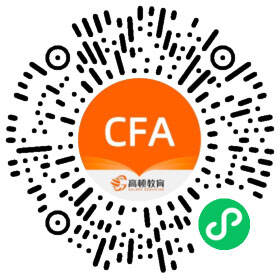2016 CFA level I考纲变动分析
2016年 CFA level II考纲变动的科目为:数量、经济、财报、固收、衍生和组合;
变动较大的科目为:数量、固收和组合;
其中,数量新增一个 reading;固收删除一个 reading,组合删除三个 reading,新增两个 reading.
具体变动情况如下:
1、数量
SS3,R10.Multiple Regression and Issues in Regression Analysis
a. formulate a multiple regression equation to describe the relation between a dependent variable and several
independent variables, determine the statistical significance of each independent variable, and interpret the
estimated coefficients and their p-values;
SS3,Reading 12. Excerpt from“Probabilistic appraoches: scenario analysis,decision trees, and
simulations”(新增考点)
a. describe steps in running a simulation;
b. explain three ways to define the probability distributions for a simulation’s variables;
c. describe how to treat correlation across variables in a simulation;
d. describe advantages of using simulations in decision making;
e. describe some common constraints introduced into simulations;
f. describe issues in using simulations in risk assessment;
g. compare scenario analysis, decision trees, and simulations.
2、经济学
SS4,Reading 13: Currency Exchange Rates: Determination and Forecasting
n. describe objectives of central bank intervention and capital controls and describe the effectiveness of
intervention and capital controls;(新增)
3、财报
SS6,Reading 20: Multinational Operations
i. explain how changes in the components of sales affect the sustainability of sales growth;(修改)
4、固收
SS14,Reading 43. The term structure and interest rate dynamics
c. describe how zero-coupon rates (spot rates) may be obtained from the par curve by bootstrapping;(新增)
g calculate and interpret the swap spread for a given maturity;(修改)
SS14,Reading 45. Valuation and Analysis: Bonds with Embedded Options
m. calculate the value of a capped or floored floating-rate bond;(删除)
SS15,Reading46. Introduction to Asset-Backed Securities(删除)
�
Evaluation Only. Created with Aspose.Pdf. Copyright 2002-2014 Aspose Pty Ltd.
5、衍生
SS17,Reading 52: Credit Default Swap
e describe the use of CDS to take advantage of valuation disparities among separate markets, such as bonds, loans,
equities, and equity-linked instruments.(新增)
6、组合
2015,SS18,Reading 53: Portfolio Concepts(删除)
SS18,Reading 53. An Introduction to Multifactor Models
d. describe and compare macroeconomic factor models, fundamental factor models, and statistical factor models;(新增)
m. explain sources of active risk, interpret tracking error, tracking risk, and theinformation ratio, and explain factor
portfolio and tracking portfolio(删除)
n. compare underlying assumptions and conclusions of the CAPM and APT model,and explain why an investor can
possibly earn a substantial premium forexposure to dimensions of risk unrelated to market movements.(删除)
f. describe uses of multifactor models and interpret the output of analyses based on multifactor models;(新增)
g. describe the potential benefits for investors in considering multiple risk dimensions when modeling asset
returns.(新增)
2015,Reading 54. Residual Risk And Return: The Information Ratio(删除)
2015,Reading 55. The Fundamental Law Of Active Management(删除)
2016,Reading 54. Analysis of Active Portfolio Management(新增)
a. describe how value added by active management is measured;
b. calculate and interpret the information ratio (ex post and ex ante) and contrast it to the Sharpe ratio;
c. state and interpret the fundamental law of active portfolio management including its component
terms—transfer coefficient, information coefficient, breadth, and active risk (aggressiveness);
d. explain how the information ratio may be useful in investment manager selection and choosing the level of
active portfolio risk;
e. compare active management strategies (including market timing and security selection) and *uate strategy
changes in terms of the fundamental law of active management;
f. describe the practical strengths and limitations of the fundamental law of active management.
2016,Reading 55. Economics and Investment Markets(新增)
a. explain the notion that to affect market values, economic factors must affect one or more of the following: (1)
default-free interest rates across maturities, (2) the timing and/or magnitude of expected cash flows, and (3) risk
premiums;
�
Evaluation Only. Created with Aspose.Pdf. Copyright 2002-2014 Aspose Pty Ltd.
b. explain the role of expe
ctations and changes in expectations in market valuation;
c. explain the relationship between the long-term growth rate of the economy, the volatility of the growth rate,
and the average level of real short-term interest rates;
d. explain how the phase of the business cycle affects policy and short-term interest rates, the slope of the term
structure of interest rates, and the relative performance of bonds of differing maturities;
e. describe the factors that affect yield spreads between non-inflation-adjusted and inflation-indexed bonds;
f. explain how the phase of the business cycle affects credit spreads and the performance of credit-sensitive
fixed-income instruments;
g. explain how the characteristics of the markets for a company’s products affect the company’s credit quality;
h. explain how the phase of the business cycle affects short-term and long-term earnings growth expectations;
i. explain the relationship between the consumption-hedging properties of equity and the equity risk premium;
j. describe cyclical effects on valuation multiples;
k. describe the implications of the business cycle for a given style strategy (value, growth, small capitalization, large
capitalization);
l. describe how economic analysis is used in sector rotation strategies;
m. describe the economic factors affecting investment in commercial real estate.

